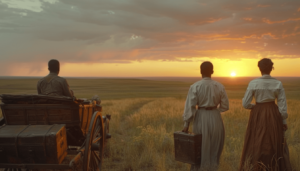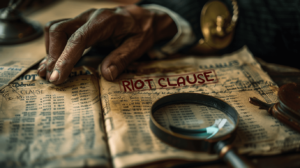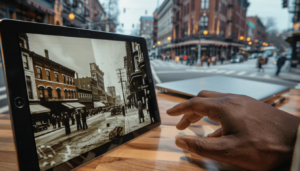Greenwood in Tulsa grew into a concentrated center of Black enterprise before 1921. John and Loula Williams exemplified local success, running businesses that helped weave a self-reliant economy.
Segregation shaped the district’s boundaries, but community vision built wealth. Researchers at the University of Denver note that dollars reportedly circulated inside Greenwood for up to 19 months, creating a closed-loop marketplace that fueled rapid growth.
The district hosted shops, services, churches, and professional offices that supported one another. That local ecosystem became a model of economic power and cultural pride for the people who lived there.
Jealousy and white supremacy converged, culminating in the 1921 destruction of 35 city blocks and hundreds of deaths. This introduction frames an ultimate guide that traces Greenwood’s rise, the atrocity that followed, and the long struggle over memory, legal claims, and reparative justice.
Key Takeaways
- The guide defines the Greenwood District as a concentrated economy led by Black entrepreneurs.
- It explains how segregation and collective vision fostered a closed-loop marketplace.
- John and Loula Williams serve as emblematic examples of wealth creation and reinvestment.
- University research on local dollar circulation highlights Greenwood’s unique prosperity.
- The 1921 attack erased generational wealth and reshaped legal and historical debates.
To explore Greenwood’s early rise and community-led prosperity, see The Birth of Black Wall Street.
What Was Black Wall Street? Greenwood’s Role in American History
Greenwood evolved into a compact, self-sustaining marketplace where commerce, culture, and civic life reinforced one another—earning it the nickname “Black Wall Street.”
Black Wall Street’s Economic Power: Greenwood’s Self-Sufficiency Under Jim Crow
Located in north Tulsa, the Greenwood District became a concentrated economic zone shaped by segregation-era restrictions. Denied access to white-owned services, Black residents built a resilient, self-sustaining community that met daily needs locally—earning Greenwood the nickname “Black Wall Street.”
How Greenwood’s Black-Owned Businesses Built Economic Independence:
- Local merchants, professionals, educators, and faith leaders formed a full-service ecosystem
- Dollars circulated within the community, fueling jobs, credit, and cultural identity
- Schools and civic groups strengthened social cohesion, economic literacy, and generational wealth
This economic model not only defied Jim Crow limitations—it became a blueprint for Black prosperity and civic empowerment.
Black-Owned Business Growth in Greenwood Before the Tulsa Race Massacre
Directories and census records show rapid business expansion in Greenwood prior to 1921. The district’s real estate, banking, and professional services earned it a reputation akin to a small financial district—often referred to as “Black Wall Street.”
This rise was fueled by migration patterns and Tulsa’s oil-driven labor market, which created demand for Black workers, entrepreneurs, and professionals. Greenwood’s economic ecosystem became a model of Black self-sufficiency and civic empowerment under Jim Crow.
The 1921 Tulsa Race Massacre: Violence, Media, and Greenwood’s Legacy
Greenwood’s success sparked economic rivalry with nearby white neighborhoods. In May 1921, a single allegation—amplified by inflammatory media and racial hostility—triggered a coordinated attack that destroyed homes, businesses, and lives.
The massacre erased decades of Black prosperity in less than 24 hours. Survivors were displaced, silenced, and denied justice for generations. For a visual timeline, see Greenwood Then and Now.
For a concise visual history, see Greenwood then and now.
Origins Of Greenwood: Migration, Segregation, And Community Vision
Migration and local strategy combined to shape Greenwood’s rapid rise. Families left the Jim Crow South for Tulsa’s oil boom where demand for services created space for Black-owned businesses. This pull met urgent push factors: legal segregation, limited land, and violent threats elsewhere.
From Jim Crow To Opportunity: Why Families Moved To Tulsa
Tulsa offered work and a chance to own property. Young people, tradesmen, and professionals arrived in growing numbers. By 1920 the neighborhood listed dozens of barbers, lawyers, and physicians; the 1921 directory recorded 191 businesses.
“Keep Wealth Within The Race”: Early Economic Philosophy And Newspapers
“Keep as much of the wealth as possible within the race.”
The Black press urged internal investment, promoting local credit, hiring, and co‑ops that offset exclusion from white banks.
Building Institutions: Schools, Churches, And Civic Life
Schools, churches, and civic groups anchored civic life. They taught skills to students, supported saving, and guided entrepreneurs.

- Community networks created credit lines and referrals.
- Growing professionals formed a visible middle class with property and firms.
- The city showed stark contrasts: opportunity coexisted with segregation and hostile policing.
Entrepreneurship And The Williams Family: A Snapshot Of Prosperity
Entrepreneurial drive and family labor built a visible corridor of shops, inns, and services on Greenwood Avenue. The Williamses moved to Tulsa to create firms that served local needs and showcased African American achievement.
John And Loula Williams As Exemplars Of Black Enterprise
Profile: John and Loula Williams ran multiple enterprises that anchored a bustling business strip. Their work created jobs and drew customers from across the city.
Local reinvestment shaped their choices. Profits funded property purchases, shop improvements, and apprenticeships for younger people.
- Their ventures complemented theaters, hotels, and professional services nearby.
- Women’s leadership, shown by Loula’s co-ownership, influenced hiring and cultural programming.
- Networks among proprietors, churches, and clubs supplied credit and mentorship.
| Aspect | Williams Contribution | Community Impact |
|---|---|---|
| Employment | Local hires and apprentices | Skill development and steady wages |
| Investment | Property and shop reinvestment | Capital formation and neighborhood stability |
| Culture | Entertainment and services | Middle-class norms and civic life |
The couple’s success helped normalize property ownership and philanthropy among district people. That visible prosperity drew admiration but also hostile attention from outside the neighborhood.

For modern echoes of this pattern across the U.S., see modern Black Wall Streets.
Black Wall Street’s Economic Engine: Businesses, Circulating Wealth, and Middle-Class Life
Greenwood’s prosperity was powered by a concentrated cluster of Black-owned theaters, hotels, grocery stores, law offices, and professional services. This ecosystem sustained neighborhood life and generated local wealth—earning the district its nickname, Black Wall Street.
191 Businesses and the Dreamland Theatre: Greenwood’s Commercial Core
By 1921, the city directory listed 191 Black-owned businesses in Greenwood. These included the Dreamland Theatre, two Black newspapers, the Stratford Hotel, Welcome Grocery, and dozens of law firms, barbershops, and tailors. This mix met nearly every daily need and kept clientele close to home, reinforcing economic independence.
Circulating Dollars for Months: Greenwood’s Closed-Loop Economy
Residents prioritized local spending, creating a powerful multiplier effect. Cash passed from shop to supplier to service provider repeatedly, strengthening community ties and building generational wealth.
- Reports suggest dollars circulated up to 30 times before leaving the district
- A University of Denver analysis found funds could remain in Greenwood for as long as 19 months
This closed-loop economy was a direct response to segregation—and a testament to Black entrepreneurial resilience.
Homeownership, Hotels, and Everyday Affluence in Greenwood
Period accounts describe comfortable middle-class homes, quality furnishings, and steady professional jobs. Apprenticeships, clerical roles, and small business ownership offered upward mobility for many residents. Greenwood’s affluence wasn’t just economic—it was cultural, civic, and deeply rooted in community pride.

| Institution | Role | Impact |
|---|---|---|
| Dreamland Theatre | Entertainment & Culture | Community gatherings and revenue flow |
| Stratford Hotel | Hospitality (largest African American-owned) | Regional reputation and jobs |
| Local Newspapers | Information & Promotion | Encouraged internal spending |
| Welcome Grocery | Retail & Supply | Daily purchases kept cash local |
Legacy: This compact business ecosystem shaped the label “black wall” and “wall street” as shorthand for urban success. For audio context on the broader economic arc, see the economic arc of African America.
Media Narratives and Racial Violence: How Newspapers Shaped the Tulsa Race Massacre
In early 20th-century Tulsa, press coverage didn’t just report events—it shaped public perception, amplified racial animus, and helped escalate one of the most devastating acts of racial violence in U.S. history. Headlines framed meaning, assigned blame, and turned rumor into emergency.
Black Investigative Journalism vs. White Newspaper Sensationalism
Black-owned newspapers followed a tradition of verification and community protection dating back to Freedom’s Journal. These outlets aimed to correct misinformation, defend Black citizens, and mobilize community response.
By contrast, some white newspapers used sensational language to inflame racial stereotypes. Neutral incidents were reframed as threats, priming white readers for panic and retaliation.
How Headlines Fueled Vigilantism and Escalation
Researchers have applied the fraud triangle to explain how media narratives contributed to mob violence:
- Social pressure: Headlines stoked fear and urgency
- Opportunity: Crowds gathered, armed, and organized
- Rationalization: Sensational framing justified vigilante action
One Tulsa Tribune headline about the Rowland–Page elevator incident stoked racial fear and mobilized white crowds. Media rhetoric influenced policing decisions and public sentiment, turning an allegation into a citywide crisis.
Greenwood residents relied on Black-owned reporting to contest lies and organize defense. The proximity of Black prosperity to white neighborhoods made incendiary headlines especially dangerous—laying the groundwork for the courthouse confrontation.
From Rumor to Catastrophe: The 1921 Tulsa Race Massacre
The sequence began with an elevator encounter between Dick Rowland and Sarah Page. The Tulsa Tribune published an inflammatory account on May 31, 1921, drawing armed crowds to the courthouse.
The Courthouse Standoff and Escalation
As tensions rose, armed groups converged. A standoff followed when citizens demanded summary action. Newspaper narratives amplified urgency and fear, pushing more people into the streets.
Deputized Mobs, Arson, and Aerial Attacks Over Greenwood
Local authorities deputized white civilians, arming them and enabling violence. Mobs looted, burned, and destroyed homes and businesses. Planes dropped incendiaries over Greenwood, and coordinated arson swept through 35 city blocks, targeting residential streets, commercial corridors, and institutions like Mount Zion Baptist Church.
The Human Toll of the 1921 Tulsa Race Massacre: Deaths, Detentions, and Destruction
Over the course of two days in late May 1921, the Tulsa Race Massacre devastated the Greenwood District—known as Black Wall Street. More than 1,000 Black-owned homes were destroyed, hundreds of businesses were burned, and an estimated 300 people were killed, with 800 injured and thousands displaced.

Detentions and Trauma: Survivors Held in Makeshift Camps
In the aftermath, survivors were forcibly detained in internment-style camps across Tulsa. These detentions compounded physical and emotional trauma, disrupted family networks, and hindered recovery efforts. The massacre erased a thriving Black economic ecosystem and shattered the civic identity of Greenwood.
“Authorities and armed civilians combined to turn rumor into a campaign of destruction.”
How the Tulsa Race Massacre Unfolded: A Sequence of Escalation
- Trigger: An elevator encounter between Dick Rowland and Sarah Page
- Media: A Tulsa Tribune headline inflamed racial tensions and mobilized white crowds
- Confrontation: Armed groups gathered at the courthouse, demanding vigilante justice
- Force: Deputized mobs, police complicity, and National Guard presence enabled widescale attacks
- Escalation: Aerial bombardment and systematic arson swept across 35 city blocks
- Impact: Thousands displaced, hundreds killed or injured, and massive property loss
A Pattern of Racial Violence and Media Complicity
The Tulsa Race Massacre fits a tragic pattern seen in other early 20th-century race riots, where allegations and sensational reporting led to pogrom-like violence. Contemporary newspaper framing legitimized vigilante action and diverted accountability away from law enforcement and city officials.
For firsthand narratives and archival perspectives, see a detailed survivor account at an archival journal entry.
Financial Fallout After the Tulsa Race Massacre: Accounting Records, Insurance Claims, and the Riot Clause Barrier
The destruction of Greenwood in the 1921 Tulsa Race Massacre erased more than homes and businesses—it obliterated the financial records that proved income, creditworthiness, and receivables. Fires consumed ledgers, invoices, and account books, severing the paper trail that tied Black-owned businesses to their economic standing.
Burned Ledgers and Lost Credit: The Collapse of Greenwood’s Financial Infrastructure
Without documentation, merchants and professionals couldn’t verify debts owed or recover lost income. The absence of accounting records crippled collections, disrupted credit lines, and halted business continuity. Greenwood’s financial ecosystem—built through years of community investment—was reduced to ash.
Insurance Denials and the Riot Clause Loophole
Insurance companies invoked riot clauses to deny claims, citing civil unrest as a legal exclusion. Despite widespread destruction, many Black policyholders received no compensation. The clause provided a convenient legal barrier that shielded insurers from liability and deepened the economic trauma.
This financial erasure compounded the physical devastation, making recovery nearly impossible for survivors. The loss of proof, protection, and payout ensured that Greenwood’s economic engine could not be rebuilt without external support or reparations.

Legal Fallout After the Tulsa Race Massacre: 193 Lawsuits, Denied Claims, and Generational Wealth Loss
In the aftermath of the 1921 Tulsa Race Massacre, survivors and business owners filed 193 lawsuits seeking approximately $1.8 million in damages. Nearly all claims were denied. One of the few exceptions favored a white gun shop owner—highlighting the racial bias embedded in the legal system.
Property Losses and the Oklahoma Commission Report
The Oklahoma Commission to Study the Tulsa Race Riot of 1921 later documented over $4 million in property losses at the time—equivalent to roughly $150 million in 2018 dollars. This report remains a foundational resource for scholars, reparations advocates, and policymakers seeking historical accountability.
How Legal Language and Government Inaction Blocked Justice
- The use of the term “riot” in newspaper coverage and legal filings allowed insurers and judges to invoke riot clauses, denying compensation to Black claimants
- City authorities and state forces, through action or omission, obstructed recovery efforts and complicated legal claims
- Survivors faced capital shortages, legal denials, and intimidation, which blunted rebuilding and erased generational wealth.For firsthand accounts of these injustices and the resilience that followed, see Survivor Stories from the 1921 Tulsa Race Massacre and Black Wall Street.
Despite limited attempts at business continuity, the systemic barriers to justice ensured that Greenwood’s economic engine could not be restored. The legal erasure compounded the physical destruction, leaving survivors without restitution and descendants without inherited assets. To review federal findings and reparations advocacy, see DOJ Report on the Tulsa Race Massacre.
“Destroyed ledgers removed the invoice trail that proves economic existence across generations.”
| Aspect | Effect | Long-Term Impact |
|---|---|---|
| Accounting Records | Proof of receivables lost | Credit collapse, business failure |
| Insurance | Riot clause denials | Denied capital for rebuilding |
| Legal Action | 193 lawsuits filed | Minimal redress, wealth erosion |
The intersection of accounting loss, insurance exclusions, and municipal response converted short-term violence into lasting economic dispossession. This pattern shows how targeted destruction can function as economic warfare, erasing capital and opportunity for generations.
What Was Black Wall Street? Why Greenwood Matters in Black Economic History
The Greenwood District of Tulsa, Oklahoma—known as Black Wall Street—was a nationally recognized hub of Black economic power in the early 20th century. Its dense network of Black-owned banks, shops, schools, and newspapers created a rare degree of fiscal autonomy. Dollars circulated locally for months, generating jobs, credit, and opportunity within a self-sustaining ecosystem.

Economic Resilience: Community-Led Finance and Rebuilding After 1921
Despite the devastation of the 1921 Tulsa Race Massacre, Greenwood residents showed remarkable resilience. Strong institutions, social ties, and local reinvestment helped rebuild parts of the district. This community-led financial model demonstrated how Black economic autonomy could sustain everyday life—even under systemic oppression. To learn how Greenwood’s financial model sustained local wealth and resilience, see Economic Lessons from Black Wall Street
Structural Racism and the Limits of Prosperity
Greenwood’s prosperity did not shield it from racial violence. Researchers emphasize that law enforcement complicity, biased media coverage, and insurance exclusions turned Black success into a target. These systemic barriers blocked recovery and erased generational wealth.
Greenwood’s Legacy: Autonomy, Injustice, and the Wealth Gap Today
Greenwood’s story matters because it reveals both the power of Black economic autonomy and the enduring costs of systemic racism. The destruction of Black Wall Street wasn’t just physical—it was financial, legal, and psychological. That legacy continues to shape racial wealth gaps, reparations debates, and economic justice movements today.
To understand how Greenwood’s legacy informs today’s economic justice efforts, see
The Legacy of Black Wall Street.
| Feature | Role | Outcome |
|---|---|---|
| Local Circulation | Kept capital in the neighborhood | Short-term growth, long-term target |
| Institutions | Banking, press, schools | Community cohesion, sustainable jobs |
| External Forces | Police, insurers, media | Legal denial, wealth erosion |
Scholars link Greenwood to broader patterns in U.S. history; for a concise overview see Origins of Black Wall Street. Understanding this case helps design policies that protect community economies rather than expose them to harm.
Scholarship and Frameworks: From the Fraud Triangle to the Racial Violence Triangle
Scholars have repurposed the classic fraud triangle—pressure, opportunity, and rationalization—to explain how collective racial violence gained momentum in early 20th-century America. Denver researchers adapted this model to study ten incidents between 1873 and 1943, including the Tulsa Race Massacre and the destruction of Rosewood.

Applying Pressure, Opportunity, and Rationalization to Racial Violence
- Pressure: Economic success, local competition, and social resentment raised tensions in cities with thriving Black communities
- Opportunity: Weak oversight, biased policing, and permissive civic norms allowed mobs to act with impunity
- Rationalization: Media narratives, racial stereotypes, and political rhetoric framed attacks as defensive or justified
This framework helps explain how prosperity became a trigger for violence—and why systemic failures enabled it.
Accounting and Record-Keeping: From Slavery to Jim Crow
Scholar Kimberly Jones traced the arc of accounting from enslaved people recorded as assets to freed communities keeping ledgers. This history reveals how record-keeping underpinned both vulnerability and resilience—and why the destruction of financial documentation in events like Tulsa had lasting consequences.
The framework challenges Booker T. Washington’s belief that economic progress alone could guarantee safety. Empirical studies, including the Oklahoma Commission Report, show that Black prosperity often increased racial animus, especially when paired with media distortion and legal exclusion.
Policy Lessons from Historical Analysis
To reduce conditions that enable racial violence, scholars recommend:
- Strengthening media standards to prevent inflammatory coverage
- Protecting financial and legal records from erasure
- Reforming insurance policies to eliminate riot clause loopholes
- Improving oversight and accountability in law enforcement and civic response
Beyond Tulsa: A National Pattern of Attacks on Black Prosperity
Coordinated attacks on prosperous Black districts occurred across the U.S. in the early 20th century. Events in East St. Louis (1917) and Rosewood (1923) mirror Tulsa’s destruction and reveal a national pattern of targeted dispossession.
- East St. Louis: At least 50 murders and 200 homes burned
- Rosewood: Delayed compensation awarded decades later
- Tulsa: Survivors and descendants largely denied restitution
Commissions such as the Oklahoma Commission to Study the Tulsa Race Riot of 1921 documented property losses and survivor testimony, shaping today’s reparations debates.
Cultural Violence and Its Enduring Impact on Black Professionals
Cultural violence continues to affect Black professionals and families. Accountants, lawyers, and business owners face:
- Biased evaluations
- Reduced client referrals
- Limited access to capital
The loss of property and foregone compounding returns echo across generations, contributing to persistent racial wealth gaps and barriers to upward mobility.
“Commissions and studies provide the information needed to shape reparative policy and classroom curricula.”
Paths Toward Repair include targeted funds, legal reform, and sustained investment in affected communities. Students and high school teachers should use commission reports and case studies to ground lessons about restitution and civic responsibility. For advocacy resources on reparations research, see a concise report on reparations and.
Conclusion: Black Wall Street’s Legacy and the Urgent Case for Reparative Justice
The economic success of Tulsa’s Greenwood District—known as Black Wall Street—became a target in 1921. The Tulsa Race Massacre erased capital, destroyed financial records, and shattered futures almost overnight. Homes, businesses, and generational wealth were lost in a coordinated act of racial violence.
Black Wall Street remains both a model of community-led economic development and a cautionary tale about how media, law, and policy can enable systemic harm. The massacre’s aftermath exposed how biased reporting, riot clause exclusions, and government inaction compounded trauma and blocked recovery.
University studies and the Oklahoma Commission to Study the Tulsa Race Riot of 1921 documented over $4 million in property losses—equivalent to $150 million in today’s dollars—and traced the legal and institutional mechanisms that denied redress. These findings support urgent calls for reform in:
- Insurance policy language
- Financial record protection
- Civic oversight and accountability
Educators, students, and policymakers should integrate Tulsa Race Massacre resources and commission reports into high school curricula and civic education. Doing so helps communities:
- Design resilient, inclusive economies
- Guard against future racial violence and dispossession
- Honor the legacy of those who built Greenwood and fought to preserve it
The story of Black Wall Street is not just history—it’s a blueprint for justice, memory, and repair.
